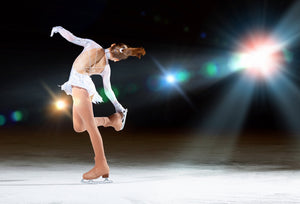Competitive figure skating is as exciting for fans as it is for the competitors. As spectators, we never know what’s going to happen when a skater steps onto the ice. Similarly, figure skaters enter the rink knowing that any given routine could go horribly wrong. However, it’s up to the judges to officially decide what score each skater earned.
Whether you’re a skater, the parent of a skater or simply a figure skating fan, it can be difficult to understand how the judge’s reach their scores. This guide will introduce you the figure skating scoring system and the basic rules of figure skating, so you can better understand the sport, whether you’re watching a regional competition from the stands or viewing the Olympics on TV.
Figure Skating Rules and Scoring
It’s no secret that Olympic figure skating rules can be notoriously difficult to grasp. This guide highlights some of the most confusing parts of single and team figure skating rules to help you enjoy this popular sport more fully, no matter what the level of competition.
The International Judging System (IJS) features a judging panel whose primary job is to grade each technical element performed by the skater. At large competitions, the panel includes nine judges, but at smaller competitions, the judging panel may include just four to seven judges. These judges grade each element of the routine, such as a jump, spin or other maneuver. Each element is assigned a numeric base value as well as a Grade of Execution (GOE).
The GOE accounts for the artistic value of the skater’s routine or program. It is used to score how successfully the skater or pair of skaters performed each element — spins, jumps, lifts, steps ¬— of their program. The GOE of each element can range from +3 to –3, and this score is added to the element’s base value. For example, if a jump has a base value of 10.3 and the skater scores a GOE of positive 2.5 on it, the total points for that jump would be 12.8.
Skating Programs Explained
Each figure skating program has its own requirements. For instance, the women’s short program must include a combination spin, a flying spin, a double or triple axel, a combination jumping pass, a triple jump, a step sequence and a sideways-leaning or layback spin. Each program, whether men’s or women’s, includes a required number of steps, spins and jumps that must be performed.
Another aspect of figure skating scoring is that jumps performed in the second half of a routine earn a 10 percent bonus on top of the base value of the maneuver. This is because more endurance, strength and skill are required to perform these maneuvers once a skater becomes fatigued. In Olympic free skate competitions, each element is limited to a maximum number of performances, so a skater cannot pad their routine with one or two high-scoring maneuvers.
Find Your Figure Skates at American Athletic Shoe Co.
Figure skating is a sport governed by many rules and requirements. There are even figure skating costume rules, such as “a skater’s body must be 50 percent covered,” which are enforced by the International Skating Union. But the athleticism and excitement embodied by competitive figure skating is what draws participants and fans back year after year.
Before hitting the rink for competition, every advanced figure skater needs a pair of comfortable, durable, supportive and fashionable skates — and American Athletic Shoe Co. is the place to find them. Shop our selection online now and follow us on Instagram, Facebook, Twitter and Pinterest to find out more about our latest designs and promos.

